Characterization of Two-Component System CitB Family in Salmonella Pullorum
Abstract
:1. Introduction
2. Results
2.1. Deletion of TCSs of the CitB Family Does Not Affect Growth and the Results of Biochemical Tests
2.2. Deletion of TCSs of the CitB Family Increases the Biofilm Formation and the Resistance to Aminoglycosides Drugs under Anaerobic Conditions
2.3. The Dpi TCS Contributes to the Survival of S. Pullorum in Hyperosmotic and Oxidative Environments
2.4. Deletion of TCSs of the CitB Family Increases the Growth in Egg Albumen and Virulence to Chicken Embryo
2.5. Deletion of Dpi TCS Is Detrimental to Long-Term Colonization of the Small Intestine but Does Not Affect the Expression of the Fimbrial Protein
3. Discussion
4. Materials and Methods
4.1. Bacterial Strains and Growth Conditions
4.2. Construction of the ΔcitAB, ΔdcuSR, ΔdpiBA and Δ3 Mutants
4.3. Growth Curves Measurement
4.4. Biochemical Tests
4.5. Biofilm Formation Assay
4.6. Antimicrobial Susceptibility Test
4.7. Stress Assays
4.8. Growth in Egg Albumen
4.9. Chicken Embryo Infection Model
4.10. Chicken Infection Model
4.11. Cellular Uptake and Proliferation Assay
4.12. Cloning, Expression, and Purification of Recombinant Fimbrial Protein
4.13. Rabbit Immunization and Polyclonal Antibodies Production
4.14. The Titer Detection of Polyclonal Antibodies
4.15. Western Blotting Analysis
4.16. Ethical Statement
4.17. Statistical Analysis
Supplementary Materials
Author Contributions
Funding
Institutional Review Board Statement
Informed Consent Statement
Data Availability Statement
Conflicts of Interest
References
- Tian, Q.; Zhou, W.; Si, W.; Yi, F.; Hua, X.; Yue, M.; Chen, L.; Liu, S.; Yu, S. Construction of Salmonella Pullorum Ghost by Co-Expression of Lysis Gene E and the Antimicrobial Peptide SMAP29 and Evaluation of Its Immune Efficacy in Specific-Pathogen-Free Chicks. J. Integr. Agric. 2018, 17, 197–209. [Google Scholar] [CrossRef]
- Shivaprasad, H.L. Fowl Typhoid and Pullorum Disease. Rev. Sci. Tech. Int. Off. Epizoot. 2000, 19, 405–424. [Google Scholar] [CrossRef] [PubMed]
- Ribeiro, S.A.M.; de Paiva, J.B.; Zotesso, F.; Lemos, M.V.F.; Berchieri Jánior, Â. Molecular Differentiation between Salmonella enterica Subsp enterica Serovar Pullorum and Salmonella enterica Subsp enterica Serovar Gallinarum. Braz. J. Microbiol. 2009, 40, 184–188. [Google Scholar] [CrossRef] [PubMed]
- Wigley, P.; Berchieri, A.; Page, K.L.; Smith, A.L.; Barrow, P.A. Salmonella enterica Serovar Pullorum Persists in Splenic Macrophages and in the Reproductive Tract during Persistent, Disease-Free Carriage in Chickens. Infect. Immun. 2001, 69, 7873–7879. [Google Scholar] [CrossRef]
- Hu, Y.; Wang, Z.; Qiang, B.; Xu, Y.; Chen, X.; Li, Q.; Jiao, X. Loss and Gain in the Evolution of the Salmonella enterica Serovar Gallinarum Biovar Pullorum Genome. mSphere 2019, 4, e00627-18. [Google Scholar] [CrossRef]
- Haider, G.; Chowdhury, E.H.; Hossain, M. Mode of Vertical Transmission of Salmonella enterica Sub. enterica Serovar Pullorum in Chickens. Afr. J. Microbiol. Res. 2014, 8, 1344–1351. [Google Scholar] [CrossRef]
- Guo, R.; Li, Z.; Jiao, Y.; Geng, S.; Pan, Z.; Chen, X.; Li, Q.; Jiao, X. O-Polysaccharide Is Important for Salmonella Pullorum Survival in Egg Albumen, and Virulence and Colonization in Chicken Embryos. Avian Pathol. 2017, 46, 535–540. [Google Scholar] [CrossRef]
- Salmonella Pullorum, Pullorum Disease, “Bacillary White Diarrhoea”. Available online: https://www.thepoultrysite.com/disease-guide/salmonella-pullorum-pullorum-disease-bacillary-white-diarrhoea (accessed on 6 July 2022).
- Zhou, X.; Kang, X.; Zhou, K.; Yue, M. A Global Dataset for Prevalence of Salmonella Gallinarum between 1945 and 2021. Sci. Data 2022, 9, 495. [Google Scholar] [CrossRef]
- Barrow, P.A.; Freitas Neto, O.C. Pullorum Disease and Fowl Typhoid—New Thoughts on Old Diseases: A Review. Avian Pathol. 2011, 40, 1–13. [Google Scholar] [CrossRef]
- Schat, K.A.; Nagaraja, K.V.; Saif, Y.M. Pullorum Disease: Evolution of the Eradication Strategy. Avian Dis. 2021, 65, 227–236. [Google Scholar] [CrossRef]
- Bäumler, A.J.; Hargis, B.M.; Tsolis, R.M. Tracing the Origins of Salmonella Outbreaks. Science 2000, 287, 50–52. [Google Scholar] [CrossRef]
- West, A.H.; Stock, A.M. Histidine Kinases and Response Regulator Proteins in Two-Component Signaling Systems. Trends Biochem. Sci. 2001, 26, 369–376. [Google Scholar] [CrossRef]
- Jacob-Dubuisson, F.; Mechaly, A.; Betton, J.-M.; Antoine, R. Structural Insights into the Signalling Mechanisms of Two-Component Systems. Nat. Rev. Microbiol. 2018, 16, 585–593. [Google Scholar] [CrossRef]
- Hua, J.; Jia, X.; Zhang, L.; Li, Y. The Characterization of Two-Component System PmrA/PmrB in Cronobacter sakazakii. Front. Microbiol. 2020, 11, 903. [Google Scholar] [CrossRef]
- Groisman, E.A.; Duprey, A.; Choi, J. How the PhoP/PhoQ System Controls Virulence and Mg2+ Homeostasis: Lessons in Signal Transduction, Pathogenesis, Physiology, and Evolution. Microbiol. Mol. Biol. Rev. 2021, 85, e00176-20. [Google Scholar] [CrossRef]
- Kato, A.; Groisman, E.A. Howard Hughes Medical Institute. The PhoQ/PhoP Regulatory Network of Salmonella enterica. Bact. Signal Transduct. Netw. Drug Targets 2008, 631, 7–21. [Google Scholar] [CrossRef]
- Marchal, K.; De Keersmaecker, S.; Monsieurs, P.; van Boxel, N.; Lemmens, K.; Thijs, G.; Vanderleyden, J.; De Moor, B. In Silico Identification and Experimental Validation of PmrAB Targets in Salmonella Typhimurium by Regulatory Motif Detection. Genome Biol. 2004, 5, R9. [Google Scholar] [CrossRef]
- Gunn, J.S.; Lim, K.B.; Krueger, J.; Kim, K.; Guo, L.; Hackett, M.; Miller, S.I. PmrA–PmrB-Regulated Genes Necessary for 4-Aminoarabinose Lipid A Modification and Polymyxin Resistance. Mol. Microbiol. 1998, 27, 1171–1182. [Google Scholar] [CrossRef]
- Roland, K.L.; Martin, L.E.; Esther, C.R.; Spitznagel, J.K. Spontaneous PmrA Mutants of Salmonella Typhimurium LT2 Define a New Two-Component Regulatory System with a Possible Role in Virulence. J. Bacteriol. 1993, 175, 4154–4164. [Google Scholar] [CrossRef]
- Arricau, N.; Hermant, D.; Waxin, H.; Ecobichon, C.; Duffey, P.S.; Popoff, M.Y. The RcsB-RcsC Regulatory System of Salmonella Typhi Differentially Modulates the Expression of Invasion Proteins, Flagellin and Vi Antigen in Response to Osmolarity. Mol. Microbiol. 1998, 29, 835–850. [Google Scholar] [CrossRef]
- Delgado, M.A.; Mouslim, C.; Groisman, E.A. The PmrA/PmrB and RcsC/YojN/RcsB Systems Control Expression of the Salmonella O-Antigen Chain Length Determinant. Mol. Microbiol. 2006, 60, 39–50. [Google Scholar] [CrossRef]
- Kaspar, S.; Perozzo, R.; Reinelt, S.; Meyer, M.; Pfister, K.; Scapozza, L.; Bott, M. The Periplasmic Domain of the Histidine Autokinase CitA Functions as a Highly Specific Citrate Receptor. Mol. Microbiol. 1999, 33, 858–872. [Google Scholar] [CrossRef]
- Liu, M.; Hao, G.; Li, Z.; Zhou, Y.; Garcia-Sillas, R.; Li, J.; Wang, H.; Kan, B.; Zhu, J. CitAB Two-Component System-Regulated Citrate Utilization Contributes to Vibrio cholerae Competitiveness with the Gut Microbiota. Infect. Immun. 2019, 87, e00746-18. [Google Scholar] [CrossRef]
- Miller, C.; Ingmer, H.; Thomsen, L.E.; Skarstad, K.; Cohen, S.N. DpiA Binding to the Replication Origin of Escherichia coli Plasmids and Chromosomes Destabilizes Plasmid Inheritance and Induces the Bacterial SOS Response. J. Bacteriol. 2003, 185, 6025–6031. [Google Scholar] [CrossRef]
- Mandin, P.; Gottesman, S. A Genetic Approach for Finding Small RNAs Regulators of Genes of Interest Identifies RybC as Regulating the DpiA/DpiB Two-Component System. Mol. Microbiol. 2009, 72, 551–565. [Google Scholar] [CrossRef]
- Janausch, I.G.; Garcia-Moreno, I.; Unden, G. Function of DcuS from Escherichia coli as a Fumarate-Stimulated Histidine Protein Kinase in vitro *. J. Biol. Chem. 2002, 277, 39809–39814. [Google Scholar] [CrossRef]
- Jiang, Y.; Chen, B.; Duan, C.; Sun, B.; Yang, J.; Yang, S. Multigene Editing in the Escherichia coli Genome via the CRISPR-Cas9 System. Appl. Environ. Microbiol. 2015, 81, 2506–2514. [Google Scholar] [CrossRef]
- M100Ed32|Performance Standards for Antimicrobial Susceptibility Testing, 32nd ed. Available online: https://clsi.org/standards/products/microbiology/documents/m100/ (accessed on 11 July 2022).
- Vazquez-Torres, A.; Xu, Y.; Jones-Carson, J.; Holden, D.W.; Lucia, S.M.; Dinauer, M.C.; Mastroeni, P.; Fang, F.C. Salmonella Pathogenicity Island 2-Dependent Evasion of the Phagocyte NADPH Oxidase. Science 2000, 287, 1655–1658. [Google Scholar] [CrossRef]
- Setta, A.; Barrow, P.A.; Kaiser, P.; Jones, M.A. Immune Dynamics Following Infection of Avian Macrophages and Epithelial Cells with Typhoidal and Non-Typhoidal Salmonella enterica Serovars; Bacterial Invasion and Persistence, Nitric Oxide and Oxygen Production, Differential Host Gene Expression, NF-ΚB Signalling and Cell Cytotoxicity. Vet. Immunol. Immunopathol. 2012, 146, 212–224. [Google Scholar] [CrossRef]
- Yue, M.; Schifferli, D.M. Allelic variation in Salmonella: An underappreciated driver of adaptation and virulence. Front Microbiol. 2014, 4, 419. [Google Scholar] [CrossRef]
- Yue, M.; Han, X.; De Masi, L.; Zhu, C.; Ma, X.; Zhang, J.; Wu, R.; Schmieder, R.; Kaushik, R.S.; Fraser, G.P.; et al. Allelic variation contributes to bacterial host specificity. Nat Commun. 2015, 6, 8754. [Google Scholar] [CrossRef]
- Kolenda, R.; Ugorski, M.; Grzymajlo, K. Everything You Always Wanted to Know About Salmonella Type 1 Fimbriae, but Were Afraid to Ask. Front. Microbiol. 2019, 10, 1017. [Google Scholar] [CrossRef]
- Yue, M.; Rankin, S.C.; Blanchet, R.T.; Nulton, J.D.; Edwards, R.A.; Schifferli, D.M. Diversification of the Salmonella Fimbriae: A Model of Macro- and Microevolution. PLoS ONE 2012, 7, e38596. [Google Scholar] [CrossRef]
- Kohli, N.; Crisp, Z.; Riordan, R.; Li, M.; Alaniz, R.C.; Jayaraman, A. The Microbiota Metabolite Indole Inhibits Salmonella Virulence: Involvement of the PhoPQ Two-Component System. PLoS ONE 2018, 13, e0190613. [Google Scholar] [CrossRef]
- Miller, S.I.; Mekalanos, J.J. Constitutive Expression of the PhoP Regulon Attenuates Salmonella Virulence and Survival within Macrophages. J. Bacteriol. 1990, 172, 2485–2490. [Google Scholar] [CrossRef]
- De la Cruz, M.A.; Pérez-Morales, D.; Palacios, I.J.; Fernández-Mora, M.; Calva, E.; Bustamante, V.H. The Two-Component System CpxR/A Represses the Expression of Salmonella Virulence Genes by Affecting the Stability of the Transcriptional Regulator HilD. Front. Microbiol. 2015, 6, 807. [Google Scholar] [CrossRef]
- Khanal, D.R.; Pokhrel, R.; Bajracharya, N.; Khanal, S.; Shrestha, P. Isolation and Genomic Identification of Salmonella Pullorum in the Poultry Farms of Nepal. Nepal. Vet. J. 2017, 34, 1–5. [Google Scholar] [CrossRef]
- Yamamoto, K.; Matsumoto, F.; Oshima, T.; Fujita, N.; Ogasawara, N.; Ishihama, A. Anaerobic Regulation of Citrate Fermentation by CitAB in Escherichia coli. Biosci. Biotechnol. Biochem. 2008, 72, 3011–3014. [Google Scholar] [CrossRef]
- Foley, S.L.; Johnson, T.J.; Ricke, S.C.; Nayak, R.; Danzeisen, J. Salmonella Pathogenicity and Host Adaptation in Chicken-Associated Serovars. Microbiol. Mol. Biol. Rev. MMBR 2013, 77, 582–607. [Google Scholar] [CrossRef]
- Yin, J.; Chen, Y.; Xie, X.; Xia, J.; Li, Q.; Geng, S.; Jiao, X. Influence of Salmonella enterica Serovar Pullorum Pathogenicity Island 2 on Type III Secretion System Effector Gene Expression in Chicken Macrophage HD11 Cells. Avian Pathol. 2017, 46, 209–214. [Google Scholar] [CrossRef] [Green Version]
- Lu, J.; Li, L.; Pan, F.; Zuo, G.; Yu, D.; Liu, R.; Fan, H.; Ma, Z. PagC Is Involved in Salmonella Pullorum OMVs Production and Affects Biofilm Production. Vet. Microbiol. 2020, 247, 108778. [Google Scholar] [CrossRef] [PubMed]
- Cabeza, M.L.; Aguirre, A.; Soncini, F.C.; Véscovi, E.G. Induction of RpoS Degradation by the Two-Component System Regulator RstA in Salmonella enterica. J. Bacteriol. 2007, 189, 7335–7342. [Google Scholar] [CrossRef]
- Yang, K.; Meng, J.; Huang, Y.; Ye, L.; Li, G.; Huang, J.; Chen, H. The Role of the QseC Quorum-Sensing Sensor Kinase in Epinephrine-Enhanced Motility and Biofilm Formation by Escherichia coli. Cell Biochem. Biophys. 2014, 70, 391–398. [Google Scholar] [CrossRef]
- de Pina, L.C.; da Silva, F.S.H.; Galvão, T.C.; Pauer, H.; Ferreira, R.B.R.; Antunes, L.C.M. The Role of Two-Component Regulatory Systems in Environmental Sensing and Virulence in Salmonella. Crit. Rev. Microbiol. 2021, 47, 397–434. [Google Scholar] [CrossRef] [PubMed]
- Kaspar, S.; Bott, M. The Sensor Kinase CitA (DpiB) of Escherichia coli Functions as a High-Affinity Citrate Receptor. Arch. Microbiol. 2002, 177, 313–321. [Google Scholar] [CrossRef] [PubMed]
- Hahn, M.M.; González, J.F.; Hitt, R.; Tucker, L.; Gunn, J.S. The Abundance and Organization of Salmonella Extracellular Polymeric Substances in Gallbladder-Mimicking Environments and In Vivo. Infect. Immun. 2021, 89, e00310-21. [Google Scholar] [CrossRef] [PubMed]
- El-Brolosy, M.A.; Stainier, D.Y.R. Genetic Compensation: A Phenomenon in Search of Mechanisms. PLoS Genet. 2017, 13, e1006780. [Google Scholar] [CrossRef]
- Li, Y.; Ed-Dra, A.; Tang, B.; Kang, X.; Müller, A.; Kehrenberg, C.; Jia, C.; Pan, H.; Yang, H.; Yue, M. Higher Tolerance of Predominant Salmonella Serovars Circulating in the Antibiotic-Free Feed Farms to Environmental Stresses. J. Hazard. Mater. 2022, 438, 129476. [Google Scholar] [CrossRef]
- Jiang, Z.; Paudyal, N.; Xu, Y.; Deng, T.; Li, F.; Pan, H.; Peng, X.; He, Q.; Yue, M. Antibiotic Resistance Profiles of Salmonella Recovered from Finishing Pigs and Slaughter Facilities in Henan, China. Front. Microbiol. 2019, 10, 1513. [Google Scholar] [CrossRef]
- Shah, D.H.; Casavant, C.; Hawley, Q.; Addwebi, T.; Call, D.R.; Guard, J. Salmonella Enteritidis Strains from Poultry Exhibit Differential Responses to Acid Stress, Oxidative Stress, and Survival in the Egg Albumen. Foodborne Pathog. Dis. 2012, 9, 258–264. [Google Scholar] [CrossRef] [Green Version]
- Rezaee, M.S.; Liebhart, D.; Hess, C.; Hess, M.; Paudel, S. Bacterial Infection in Chicken Embryos and Consequences of Yolk Sac Constitution for Embryo Survival. Vet. Pathol. 2021, 58, 71–79. [Google Scholar] [CrossRef]
- Huang, K.; Fresno, A.H.; Skov, S.; Olsen, J.E. Dynamics and Outcome of Macrophage Interaction between Salmonella Gallinarum, Salmonella Typhimurium, and Salmonella Dublin and Macrophages from Chicken and Cattle. Front. Cell. Infect. Microbiol. 2019, 9, 420. [Google Scholar] [CrossRef] [PubMed]
- Liang, H.; Xia, L.; Wu, Z.; Jian, J.; Lu, Y. Expression, Purification and Antibody Preparation of Flagellin FlaA from Vibrio Alginolyticus Strain HY9901. Lett. Appl. Microbiol. 2010, 50, 181–186. [Google Scholar] [CrossRef] [PubMed]
- Bradford, M.M. A Rapid and Sensitive Method for the Quantitation of Microgram Quantities of Protein Utilizing the Principle of Protein-Dye Binding. Anal. Biochem. 1976, 72, 248–254. [Google Scholar] [CrossRef]
- Chen, R.; Shang, H.; Niu, X.; Huang, J.; Miao, Y.; Sha, Z.; Qin, L.; Huang, H.; Peng, D.; Zhu, R. Establishment and Evaluation of an Indirect ELISA for Detection of Antibodies to Goat Klebsiella Pneumonia. BMC Vet. Res. 2021, 17, 107. [Google Scholar] [CrossRef]
- Chuang, Y.-C.; Wang, K.-C.; Chen, Y.-T.; Yang, C.-H.; Men, S.-C.; Fan, C.-C.; Chang, L.-H.; Yeh, K.-S. Identification of the Genetic Determinants of Salmonella enterica Serotype Typhimurium That May Regulate the Expression of the Type 1 Fimbriae in Response to Solid Agar and Static Broth Culture Conditions. BMC Microbiol. 2008, 8, 126. [Google Scholar] [CrossRef] [Green Version]
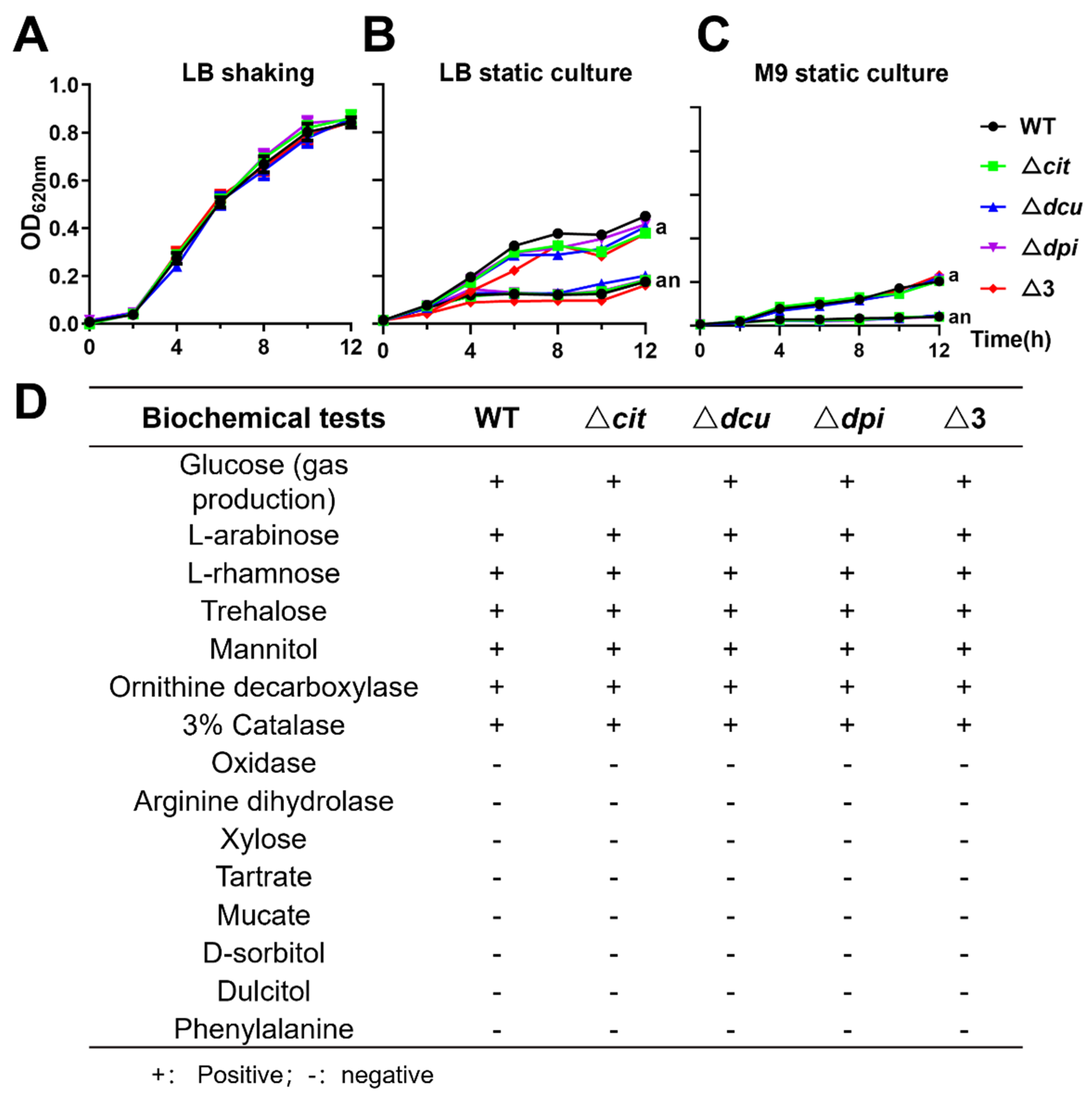
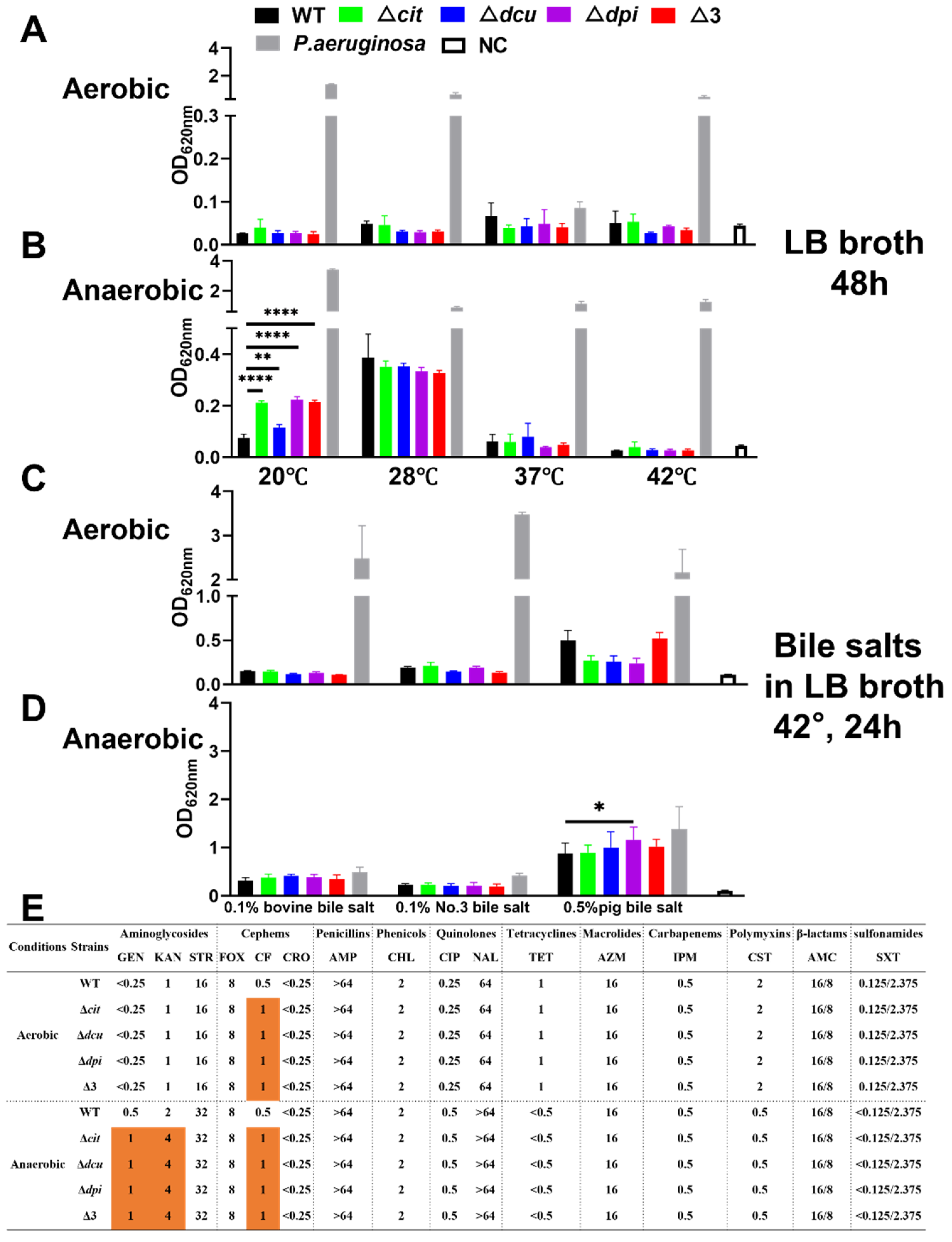
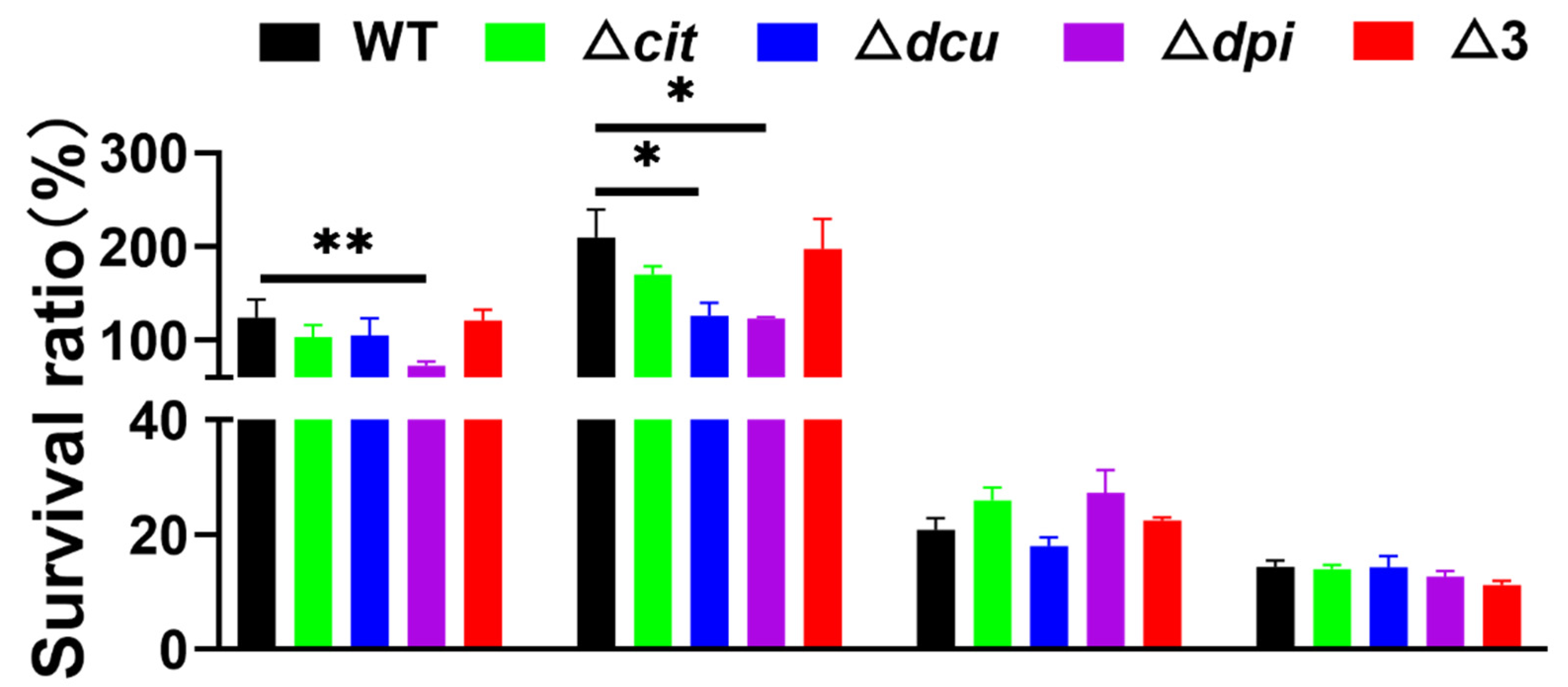
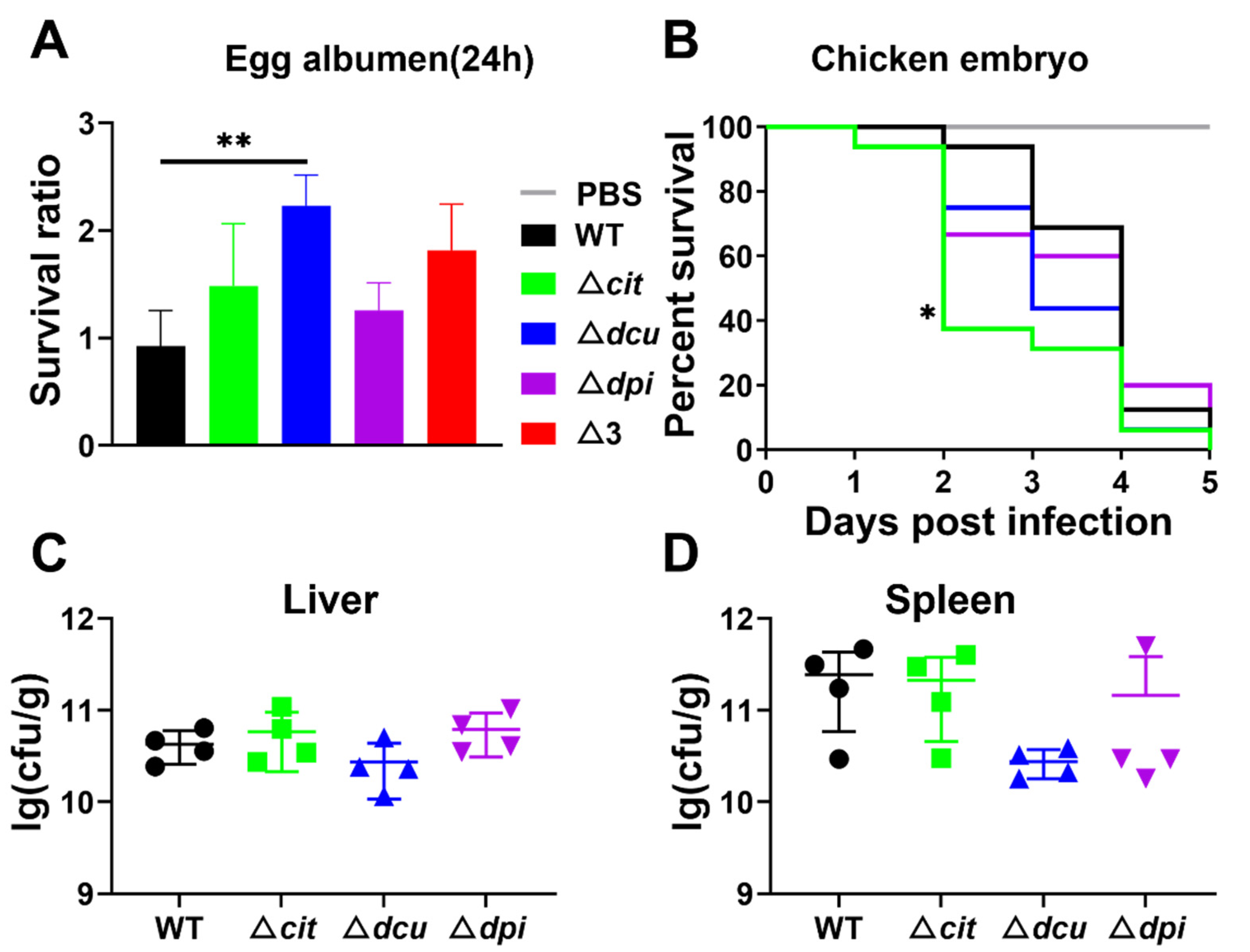
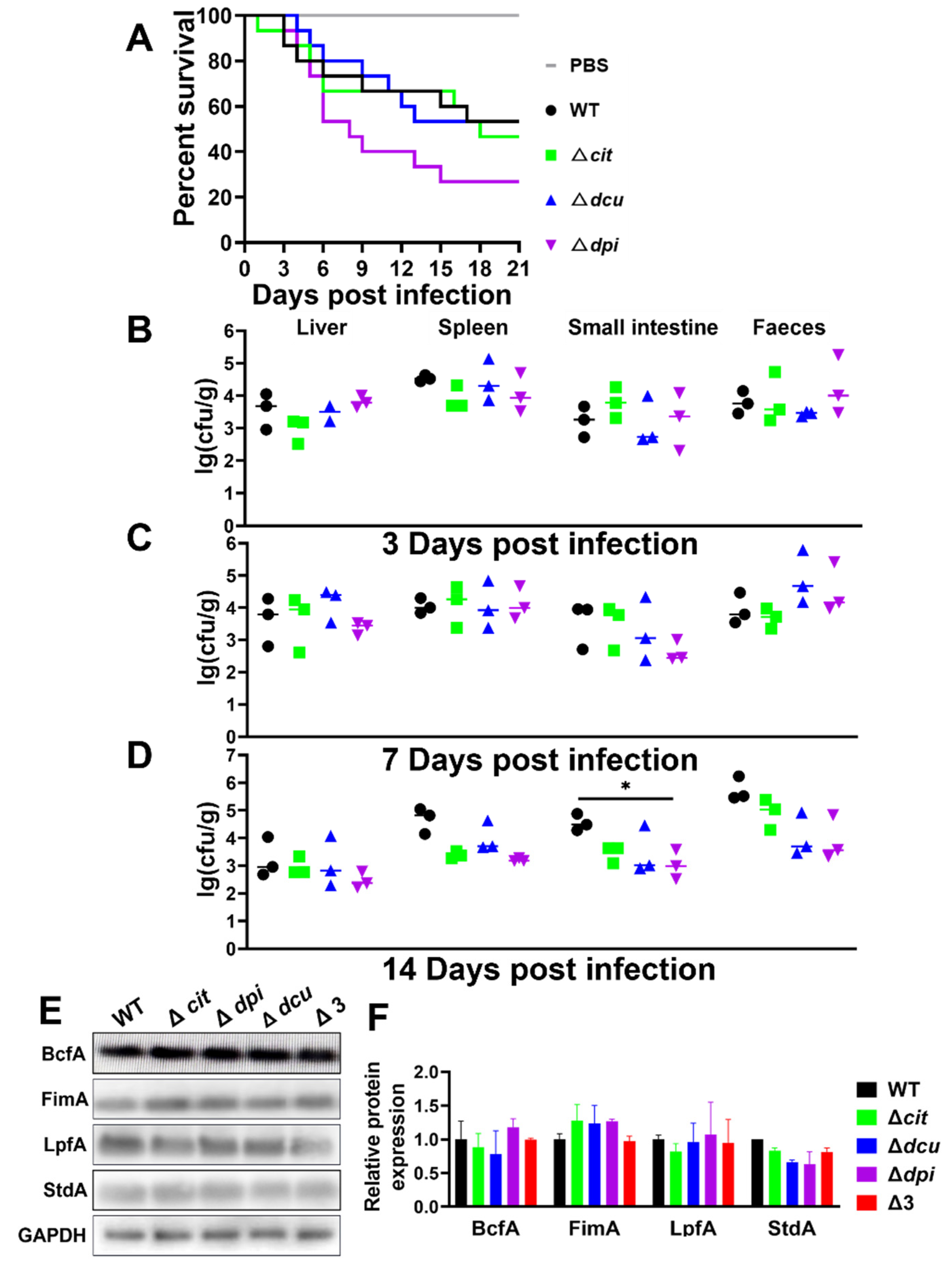
Publisher’s Note: MDPI stays neutral with regard to jurisdictional claims in published maps and institutional affiliations. |
© 2022 by the authors. Licensee MDPI, Basel, Switzerland. This article is an open access article distributed under the terms and conditions of the Creative Commons Attribution (CC BY) license (https://creativecommons.org/licenses/by/4.0/).
Share and Cite
Kang, X.; Zhou, X.; Tang, Y.; Jiang, Z.; Chen, J.; Mohsin, M.; Yue, M. Characterization of Two-Component System CitB Family in Salmonella Pullorum. Int. J. Mol. Sci. 2022, 23, 10201. https://doi.org/10.3390/ijms231710201
Kang X, Zhou X, Tang Y, Jiang Z, Chen J, Mohsin M, Yue M. Characterization of Two-Component System CitB Family in Salmonella Pullorum. International Journal of Molecular Sciences. 2022; 23(17):10201. https://doi.org/10.3390/ijms231710201
Chicago/Turabian StyleKang, Xiamei, Xiao Zhou, Yanting Tang, Zhijie Jiang, Jiaqi Chen, Muhammad Mohsin, and Min Yue. 2022. "Characterization of Two-Component System CitB Family in Salmonella Pullorum" International Journal of Molecular Sciences 23, no. 17: 10201. https://doi.org/10.3390/ijms231710201
APA StyleKang, X., Zhou, X., Tang, Y., Jiang, Z., Chen, J., Mohsin, M., & Yue, M. (2022). Characterization of Two-Component System CitB Family in Salmonella Pullorum. International Journal of Molecular Sciences, 23(17), 10201. https://doi.org/10.3390/ijms231710201





